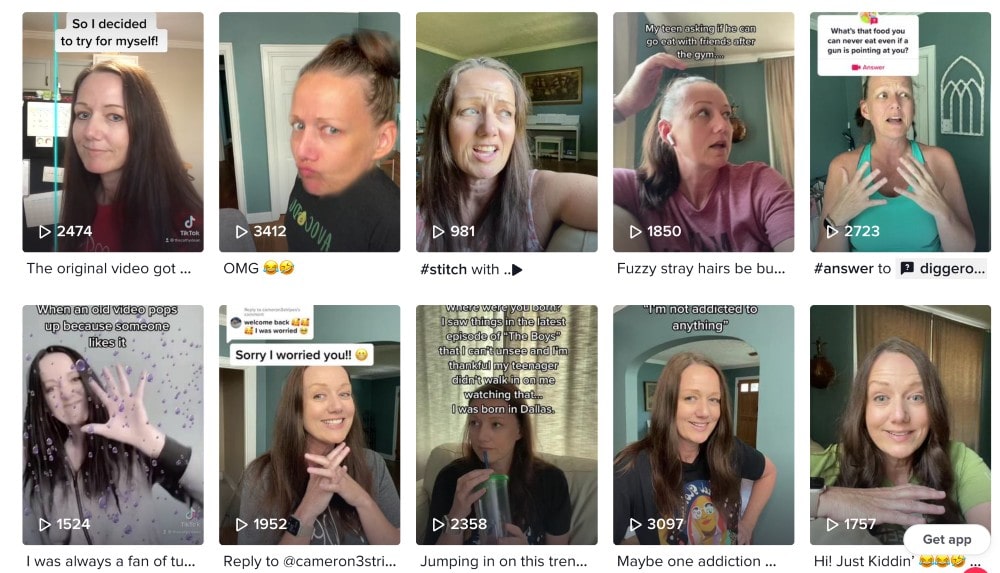Are you looking for how to promote your blog and increase your website traffic? If so, you’ve come to the right place. Blogging is a great way to share your knowledge and experience with others, but how do you get people to find your awesome content?
There’s nothing worse than coming up with a great idea for your blog and then putting a lot of time and effort into it only to have it never see the light of day.
Real talk: Growing a blog and getting more visitors in the door and then converting those visitors can be tough.
So, let’s talk about how to promote your blog effectively so that more people can discover it.
We’ll cover topics like how to use social media platforms, optimize your blog content for search engines, and build relationships with other bloggers to increase exposure.
By the end of this blog promotion post, you should have all the tools and resources necessary for successful blog promotion.
This article is quite long and thorough, so here’s a quick-jump summary for you:
1. Build Your Foundation
We won’t spend a lot of time here, because we’re assuming that you have already started a blog and have moved past the initial setup phase.
If not, make sure to check out our post on how to successfully start your first blog. In that post, we go over our top recommendations for hosting, blog design, and more.
The next step would be to create a blog business plan if you haven’t already. This will help you start thinking about the overall strategy for the growth of your blog and business.

When it comes to the actual setup, here are the most important things you need to have the right for setup to make sure that you get the most from your efforts when promoting your blog:
Blogging Platform
The right blogging platform is essential for successful blog promotion.
A good platform provides the tools, features, and flexibility needed to create a content-rich and high-performing blog that attracts readers, drives engagement, and generates leads.
WordPress is hands-down the best platform for bloggers and the only one you should be using if content marketing and SEO are important to you.
Having the right blogging platform makes it easier to optimize your blog content for search engines and provides you with the tools and customizations that you need to promote and grow your blog.
Blog Hosting
Having the right blog hosting plan for your WordPress blog is also essential for success.
Blog hosting plans provide the infrastructure necessary for reliable hosting, security, and scalability of your blog.
Without the right plan in place, your blog will suffer from slow load times and subpar performance, both of which can significantly impact visitor engagement and how search engines rank your site.
The best blog hosting plans are optimized for blogging platforms like WordPress and provide dedicated resources to ensure that your website runs smoothly no matter how much traffic you get.
Most good hosting plans also come with features like backup and restore options, database optimization tools, staging environments for testing changes to your site before they go live, and more.
Additionally, the right blog hosting plan will help protect against malicious attacks such as malware or viruses.
Many providers offer enhanced security measures like firewalls and malware scanning to ensure that your website remains safe from any potential threats.
Overall, by investing in the right blog hosting plan, you’ll be able to maximize the benefits of blogging and enjoy improved performance, enhanced security, better customer service, and more.
Our recommendation here is Bluehost. They’re super affordable, especially for beginners, have great customer service, and we’ve been using them for years.

You can get a discount through our link to get started for just $1.99/month.
Blog Design
One last very important investment to make upfront is when choosing a theme for your blog.
A well-designed website can help you stand out from the competition, increase user engagement, and drive more traffic and leads to your blog.
An effective blog design includes a visually appealing layout that’s easy to navigate, as well as features like a search bar and social media buttons for maximum discoverability.
A couple of our favorite customizable themes for beginners are Divi and Astra.
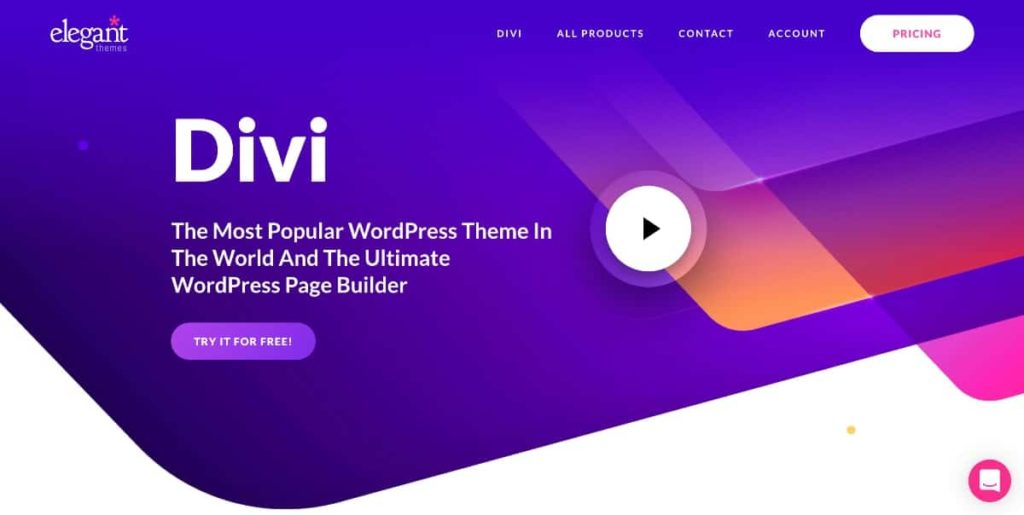
Additionally, it should be optimized for desktop and mobile users in order to provide an optimal user experience for all visitors.
Another important aspect of the right blog design is how quickly it loads. Page speed is one of the most important metrics when it comes to user experience – faster loading times mean people stick around longer, resulting in more page views and potentially higher conversions.
Optimizing images and minifying code can help improve page load times significantly.
Finally, the right blog design can help set the tone for how readers perceive your brand.
From font choices to colors and imagery used on each page – even subtle differences can make a big impact on how readers feel about your blog posts and other content.
Our favorite tool for creating images, logos, and other design elements is Canva. You can start a free trial of the Pro plan to access advanced features and a huge selection of stock photos.
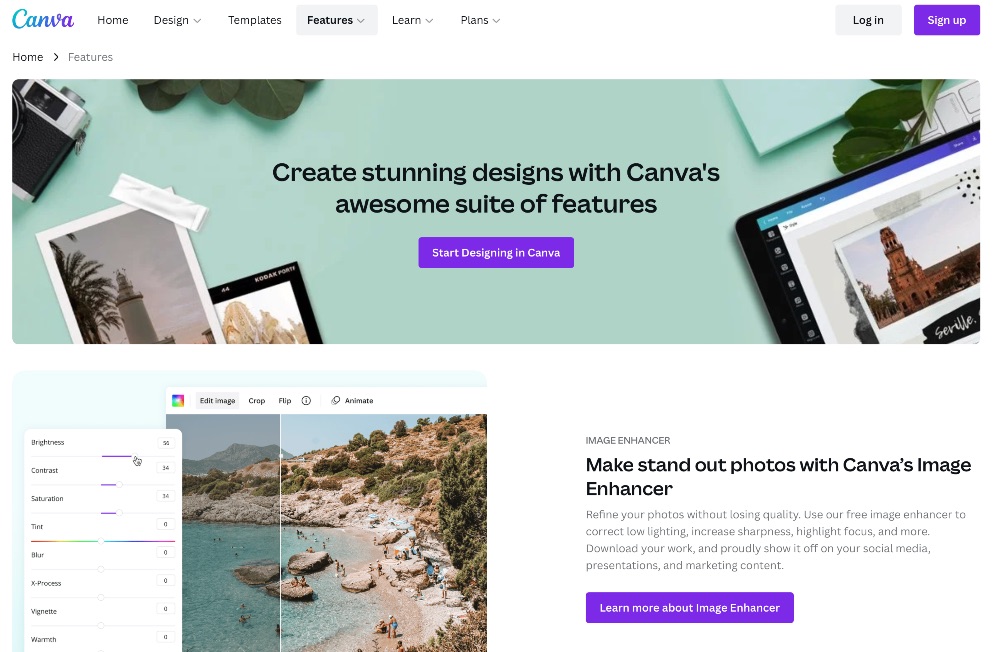
By investing in the right blog design upfront, you’ll get improved performance, enhanced discoverability for SEO and traffic, and an improved user experience overall.
2. Research and Planning
The research and planning phase is an important part of learning how to promote your blog effectively.
It’s important to create content that resonates with your target audience and performs well in search engine rankings, but you have to first take steps to learn who your target market is and how to reach them.
It is important to thoroughly research the topics you plan to write about because it will provide you with ideas and inspiration as well as make sure you’re delivering the right value to your audience.
It’s a good idea to also research how successful bloggers have approached topics similar to yours in the past, so you can get a better understanding of what works and what doesn’t.
Planning is also important because it helps ensure that your blog posts and other content are organized and structured appropriately.
Researching and planning effectively can also help increase search engine rankings for your blog by boosting the relevance of the blog posts and making sure key terms are included where appropriate.
Narrow Down Your Niche
Narrowing down your blog niche is an important part of building an audience and getting more traffic to your blog.
It helps you to focus on the specific topics that are most meaningful and relevant for your readers, while also helping you create content with more depth and accuracy.
By having a more focused target audience, you can also create better content that resonates with them and other potential customers.
You’ve probably heard the phrase that it’s better to be an expert in something than “just okay” in a variety of areas — this is at least true when it comes to blogging success.
When your audience sees how knowledgeable you are about topics related to your niche, they’ll view you as an authority figure who can be trusted for reliable information. This can help encourage people to come back for more advice and tips whenever they need it, and it also happens to be great for SEO (search engine optimization), which we’ll discuss later on.
When you focus on a narrower niche, it becomes much easier to stand out from the competition and get traffic for certain keywords.
It also allows you to appeal to a more specific audience and create highly targeted marketing campaigns that can be more successful in reaching the intended customers.
Consider your own blog niche and see if you’re casting too wide of a net.
For example, “Health and Weight Loss” is way too broad.
Instead, consider the following narrower niches:
- Fast Weight Loss for Women Over 50
- Plant-Based Nutrition for Expecting Mothers
- Keto Diet and Recipes for Families
These all have a much narrower scope and a more specific audience.
Identify Target Audience
Before you start creating content and definitely before you can learn how to promote your blog properly, it’s important to identify who your target audience is because it will help ensure that you’re delivering the right content to the right people.
When you know who your target market is, you can better understand how they think, how to write blog posts that resonate with them, and how to properly reach them.
It’s also the first step in understanding what their needs are and how you can begin to solve those needs and problems with a solution — and start earning money with your blog.
Identifying your target market or audience means understanding the demographics of the people who are most likely to be interested in reading your blog or engaging with your content.
This includes such factors as age, gender, location, profession, educational level, lifestyle, and more.
You can find out more information about the demographics of your audience using Google Analytics.

Understanding these aspects of your audience allows you to tailor and customize the writing style and topics of your blog posts so that it speaks directly to their wants and needs.
Knowing who your target market is also helps with SEO. If you’re noticing a pattern that all roads lead back to SEO, you’re not wrong.
When search engines index websites, they use algorithms based on how relevant the content is for a given keyword query. The more focused you make the content towards a certain demographic or group of individuals, the greater chance it has of ranking higher in search engine results.
Finally, understanding your target market can also help you decide which platforms you want to use to promote your blog.
Every social media platform and search platform has a different demographic of people, so it’s important to match your content with your audience and with your platform.
Keyword Research
Keyword research is an essential step to take before you promote your blog because it helps you to identify the terms and phrases that are most relevant to your target audience.
It gives you insight into how people are searching for content related to your niche and how you can optimize your content for search engines to help boost your visibility.
You can learn which keywords have high search volumes but with lower competition so that your content has its best chance of getting found in search engine results.
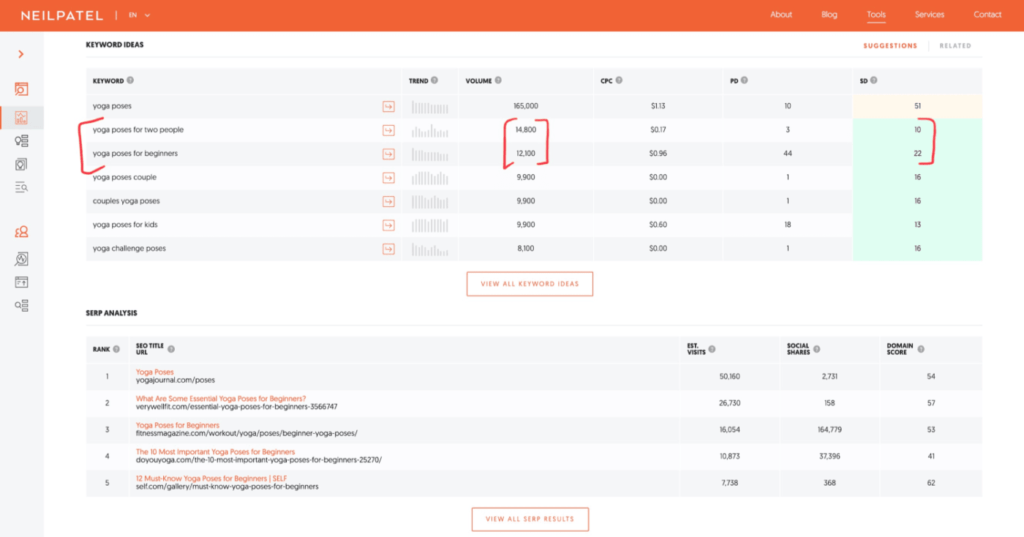
On top of that, by understanding how people search for a particular topic, you can create more targeted content with higher semantic richness.
This will make internal linking easier and help readers find what they need quickly and efficiently, increasing engagement on your blog.
By understanding what specifically people are searching for, you can also help you develop more effective and efficient marketing campaigns to learn how to promote your blog with greater accuracy.
If nothing else, keyword research can also help you understand how competitive certain topics are and may help you steer clear of certain topics that are simply too competitive.
Keyword Research Tools
Thankfully, there are a lot of keyword research tools that will help you with this task. Our favorites for keyword research specifically are Ahrefs, SEMRush, and Ubersuggest.
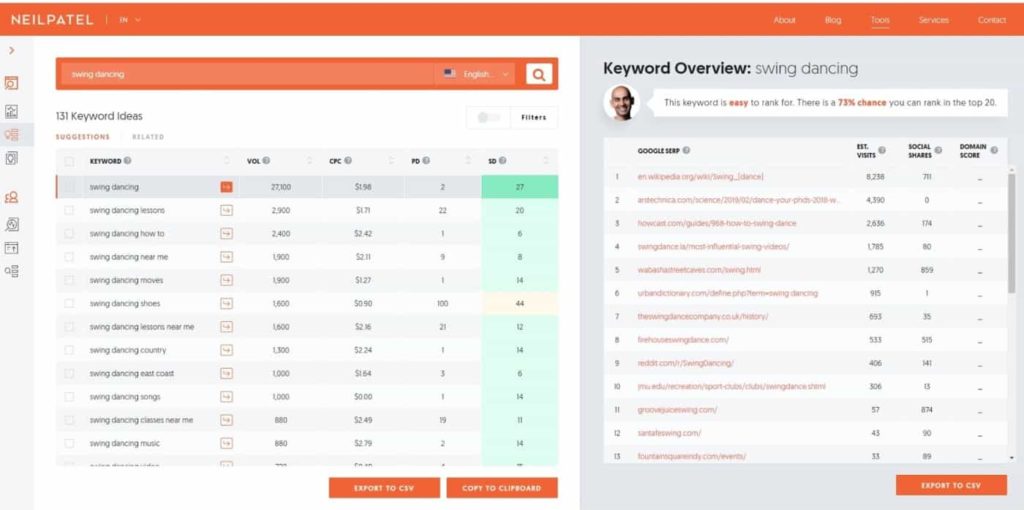
Ideally, you want to search for medium to long-tail keywords that don’t have too high of a difficulty score.
For example, “Weight Loss” is a very simple and short-tail keyword. “Weight Loss for Women Over 50” is more of a medium-tail keyword.
The more keywords you add, the longer the “tail.”
You can also use these tools for a variety of purposes beyond keyword research and we’ll discuss that in more detail when we get to the section on SEO.
Content Planning
Content planning is another important step to take when you promote your blog because it will help you make sure that you create and publish content frequently and consistently, which keeps your audience engaged and your traffic growing.
It’s not enough to just do keyword research and start writing a new blog post about that topic. You should focus on keyworded content that can help you drive traffic but also sales-centered content that will help you earn money.
Content Purpose
Every single piece of blog content that you create — every blog post that you write or video that you publish — should have a purpose.
Content to Drive Traffic
That purpose can simply be to drive traffic to your website. It doesn’t have to be related to sales. Sometimes, just driving traffic with any blog post can help your SEO and in turn, drive traffic to more important articles that do earn you money.
Planning out which keywords you want to use and what kind of posting schedule you’re going to have is important to make sure that you:
- Cover all relevant topics to your audience
- Have a steady stream of new content to please the algorithms
It also just makes your life a lot easier and frees up time to focus on other areas of your business.
Make sure to identify what your most important keywords to target are and start there.
We’ll talk more about SEO optimization and researching the competition later on in this article when we get to the section on optimization.
Content to Make Money
Another purpose for your content could be to make money. Generally, the kind of content that earns more money is the kind that solves a problem and provides a solution.
For example, if you sell courses (like we do), you can create content about how to promote your blog!
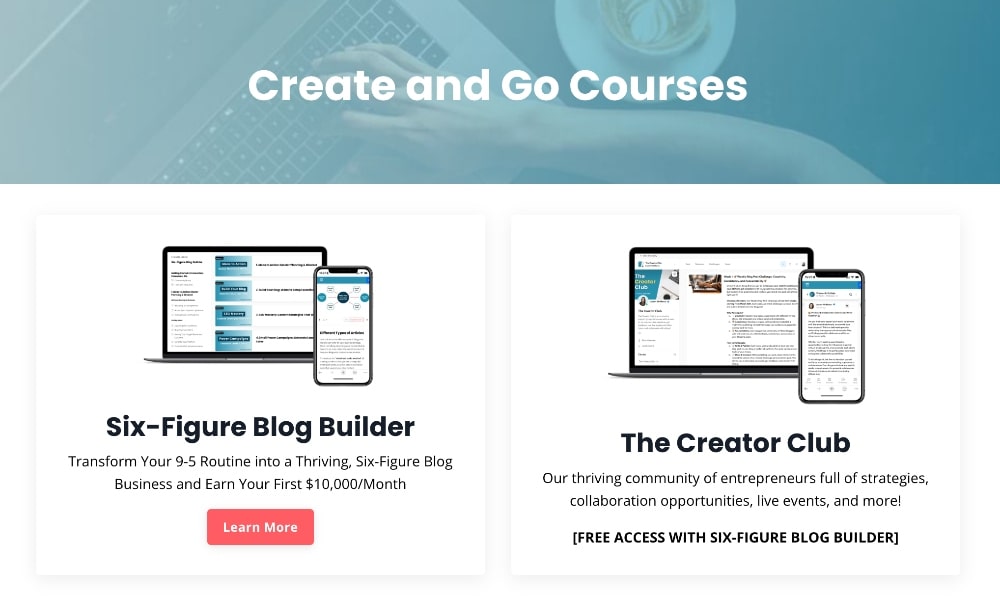
This solves a problem that our audience (you) has and our courses provide a more in-depth solution than this one blog post alone can provide.
Think of your content as providing a high-level overview of “what” to do but your paid products provide the in-depth, organized solution of exactly “how” it’s done.
Affiliate marketing, or recommending other companies’ products and services (that you don’t own), is another popular way that you can make money with your content.
All of this requires careful planning of keywords, products, and more.
Stay Organized
Make sure to create a content schedule to help you stay organized.
Having an editorial calendar in place allows for more efficient content creation by allowing you to schedule future blog posts in advance and plan how often you’ll be publishing new content. This can be especially helpful if you’re working on multiple projects concurrently or just want to ensure consistent output on a regular basis.
Having an outline in place before starting a blog post also helps keep your writing focused and prevents you from straying off topic.
AI Content Curation
AI (Artificial Intelligence) technology is quickly changing the game for content curation and promotion.
Not only does AI make writing content a lot faster and easier, but it can also suggest topics to write about that are tailored to your audience’s interests, as well as help develop more engaging titles and ideas.
The AI writing tools on the market today also come equipped with third-party integrations for grammar tools and SEO software. This means that AI makes it easier to optimize content for specific keywords, helping you rank higher in search engine results pages (SERPs).
Tools like Jasper AI to help you write full blog posts, emails, product descriptions, social media campaigns, and more.
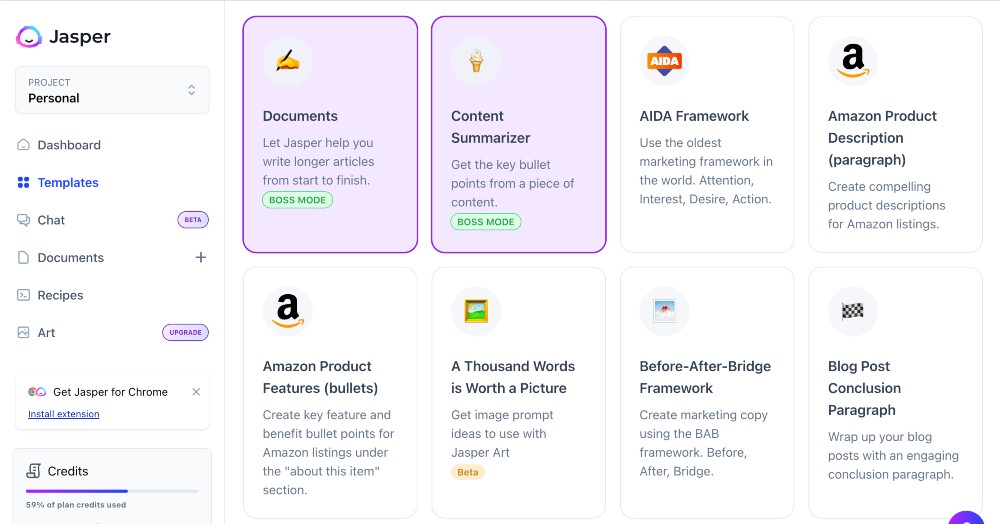
Overall, AI technology is making it easier and faster to create, optimize, and publish content with the potential of increased revenue for businesses.
Here is a list of our favorite AI writing tools.
Repurpose Content
As you may have noticed, when it comes to blog promotion, content is king. Having a steady stream of new or updated content is important, but it can be tough to pump out this much content regularly (even with the help of AI tools).
Repurposing your content is a great way to promote your blog, maximize your reach and exposure, and save you a ton of time.
Content repurposing simply means taking an existing piece of content such as a blog post or video and presenting it in different formats for different audiences.
You can actually share the same (or similar) blog post or content on multiple social media channels.
For example: After writing a blog post, you can create a podcast episode, YouTube video, Instagram story, and Pinterest pin from that same blog post.
You could also create several TikTok videos or write an email from the blog post.
When you share content on multiple social media accounts, just make sure to change and adapt the content to make sure it performs better on each of the different social media channels.
Repurposing content should always be a part of your blog promotion strategy. A good place to start is with your most popular blog posts.
Saves Time
The primary benefit of content repurposing is that it saves you time by allowing you to leverage existing posts. This helps increase the reach and impact of your original message without having to start from scratch every time.
In addition to making it easier to produce multiple versions of one piece of content with minimal effort, repurposing also allows you to share the same message with multiple audiences or in different contexts.
You can also use data from past engagements with your audience (such as how long they watched a video or how often people clicked on a link) to refine how you present the same information in future iterations.
Hire a Copywriter
Finally, in our last section on content creation and planning, I want to discuss the possibility of hiring a copywriter.
Hiring a professional copywriter or freelance writer can be a great way to take your content creation to the next level and have more content and time to promote your blog.

Copywriters have experience in creating engaging and informative content, and you can also find some with SEO experience as well to make sure your posts are optimized for search.
It can feel weird to think about hiring a copywriter when your blog is supposed to be written by you, but most successful blogs hire out most, if not all, of their content writing at some point.
Most bloggers start off writing most of it on their own but as your blog grows, you’ll find that this becomes a necessity to free up your time so that you can focus on other aspects of running your business.
You can also hire a ghostwriter, which means that the publisher author of the content remains your name and blog. The ghostwriter gets paid but doesn’t get their name attached to the content.
If you can afford the expense, hiring a copywriter is a great way to create more blog content to promote your blog in new and exciting ways.
3. Content and SEO Optimization
Content optimization is an important part of how you promote your blog, especially as it relates to SEO. But overall, optimizing your content simply means you’re getting more bang for your buck.
Content optimization helps ensure that your content reaches the widest possible audience, is discoverable in search engines, and drives conversions.
When creating content for your blog, it’s important to include keywords and phrases throughout your blog in places like your headings, subheadings, body copy, etc.
But including keywords isn’t enough though – it’s also important to make sure you have high-quality content, that is useful to readers.
We’ve already mentioned SEO (search engine optimization) quite a few times already and how important it is to increase your visibility in search engines.
Google SEO is generally considered the “king” of traffic in the blogging world because it’s generally the highest quality and most consistent, relatively speaking.
But it’s not enough to just write a bunch of content and include the right keywords in that content.
You have to make sure that your entire website as well as your content is optimized and performing well.
We’ll explore this in more depth in this section.
On-Page SEO
The first step to optimizing your website and content is to focus on the basics of SEO.
On-page SEO focuses on optimizing elements such as page titles, meta descriptions, header tags, keyword density, alt text, URLs, internal links and external links, and more.
Our favorite (free) tool for helping you with basic SEO is the RankMath plugin.

Adding keywords strategically throughout your content and using an SEO-friendly structure will help your content to start ranking in organic search. Additionally, on-page SEO also helps improve the user experience of those who are searching for information related to your topic.
Optimizing things like titles and meta descriptions can make it easier for searchers to find exactly what they’re looking for. Optimizing headers and other elements with keywords can help draw attention to key points within the body of the text so that readers have a better understanding of what the content is about.
Overall, on-page SEO ensures that all elements of your website are properly optimized so that search engine algorithms can more easily understand the purpose of your content and how it should be ranked relative to other websites competing for similar queries.
SEO Tools
When you’re ready for the next step in optimization, you should look for the best SEO tools to help you identify other areas that need improvement.
SEO tools can provide incredibly valuable insights when it comes to improving the visibility of your blog in search engines.
They can be used to identify and fix issues with technical SEO, analyze how well a page performs against competitors, check how quickly a page loads, recommend how to improve a page’s performance, and more.
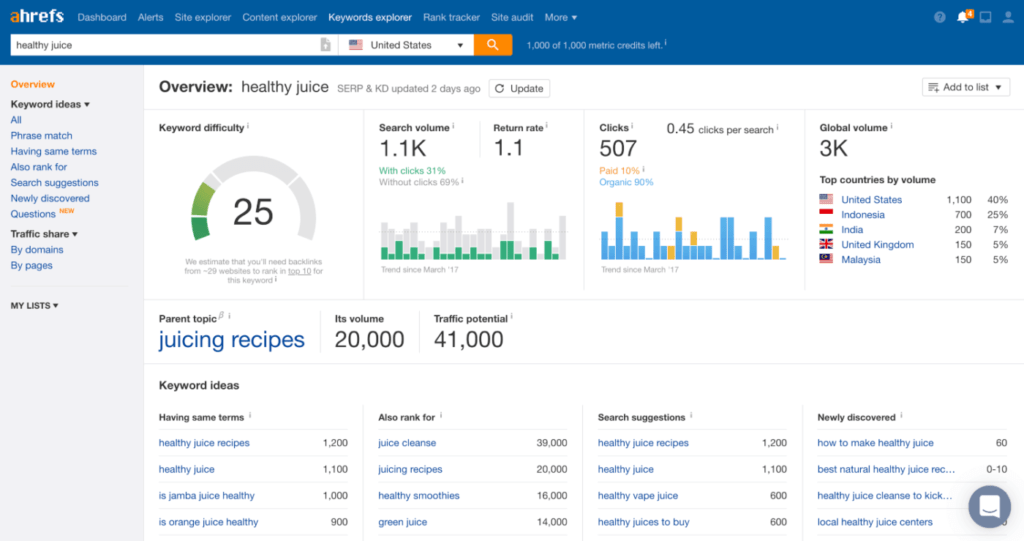
SEO rank tracker tools can help you track your site performance, including individual posts and pages. They provide detailed reports on how each page is performing in terms of impressions, clicks, and rankings.
Some SEO tools also have features that allow you to monitor how changes you make on one page affect its ranking over time so that you can better understand how Google interprets different elements of your site.
These tools also offer analytics that help measure how successful your content is at engaging readers, including how much time people spend on each page after clicking through from search engines. This data helps identify any opportunities for improvement so that you can adjust how you promote your blog accordingly.
Surfer SEO, one of our favorite tools, provides you with a ton of insights into what keywords you should include in your posts compared to what competitors who are ranking are using.
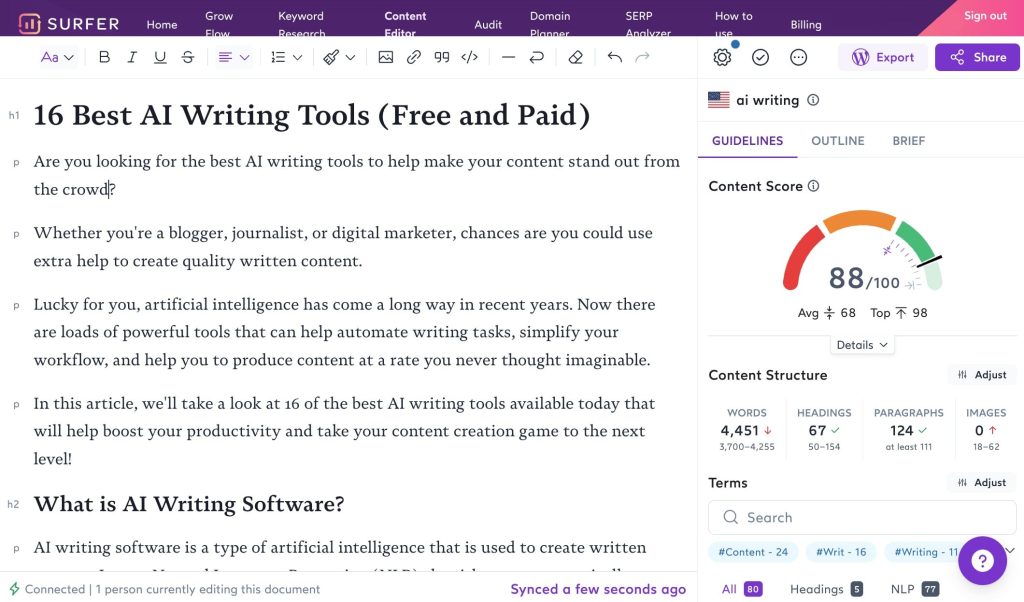
Our other favorite SEO tools include Ahrefs and SEMrush.
Overall, SEO tools are incredibly useful for helping increase the visibility of your blog in search engines and optimizing the user experience for those who find it through organic search results. Utilizing these tools regularly will ensure that your content is reaching its full potential and being seen by as many people as possible.
Content Audit
Let’s take it one step further with our SEO tools. One of the best features of some of these tools is that you can use them to do a full content audit on your site.
A content audit helps you see how well your content is performing against competitors and identify any potential opportunities to improve your performance.
It also provides insight into how users interact with your website, which can help you improve how you promote your blog.

When conducting a content audit, it’s important to look at every page on your website to see how it fits into the overall strategy and how it can be optimized for search engines.
It should include an analysis of each page’s title tags, meta descriptions, image alt text, external and internal links used, keyword density, readability score, and more.
For example, if you find that certain pages have outdated titles or meta descriptions with irrelevant keywords, you can update them to make them more SEO-friendly. And if certain pages have low readability scores or lack internal links pointing back to them from other pages on the site, you can address these issues as well.
You can identify how many words or images your other blogs are using for competing posts and optimize your content accordingly.
Overall, doing a content audit regularly is essential for optimizing and updating your content.
Competitor Analysis
Along with the content audit, SEO software tools can also help you conduct a competitor analysis. This involves researching how well your competitors are doing in terms of organic rankings, blog promotion strategies, and website structure.
By understanding how your competitors are achieving success, you can identify areas where you might be lacking and create new strategies to increase your own visibility.
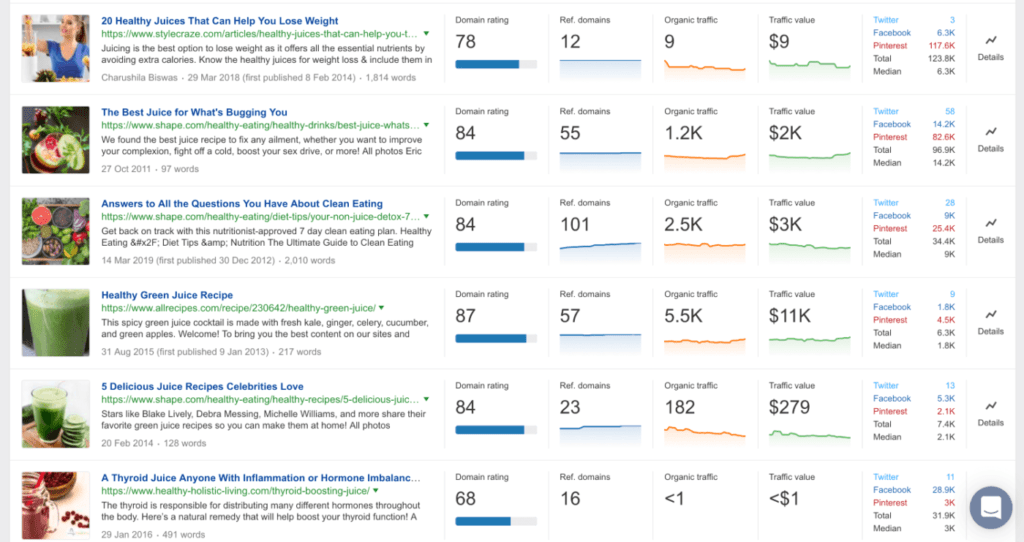
When conducting a competitor analysis, you should look at the following areas:
- Page and post titles and meta descriptions
- Structure of their content, including headings and subheadings
- Internal and external links
- How many sites are linking to their post
- What keywords they are using in their content
- What plugins they are using to increase visibility of content or information
- How often other blogs post new content and how they promote it
- What products they are selling
- What and how many images are in their posts
- Whether or not they display an email opt-in
Additionally, if they seem to be successful with certain tactics such as guest blogging or link-building campaigns then you may want to replicate those same strategies for yourself.
Take note of how they optimize their images and videos by using alt-text descriptions and other SEO best practices.
By studying how your competitors have optimized their websites for search engines, you can gain valuable insight into how you might do the same for your own blog.
Update Content
Updating your content regularly is absolutely essential for staying relevant to both your audience and Google. It is important to continuously update your content in order to keep up with the latest trends, technological advancements in your niche, and changes in consumer preferences.
By keeping your content fresh and current, you can attract new visitors and readers to your blog who may be searching for new information on a particular topic.
Aside from providing fresh, up-to-date content to your readers, there are also numerous SEO benefits associated with regularly updating your content.
Keeping track of how well your content is performing in terms of SEO will enable you to identify any potential issues that could be causing a decline in organic rankings or visibility.
Use the SEO tools that we mentioned before to do content audits and identify areas that you can update in your content.
Regularly updating existing content will help boost visitor engagement as well as increase overall website performance. Updating old blog posts or articles that have gone stale over time can not only drive more traffic but also positively impact how long users spend on a page before leaving the site.
And it’s not just blog posts… Maintaining an active presence on social media platforms is also important, so keep sharing fresh content everywhere — even if it’s updated or repurposed content.
Ultimately, updating existing blog posts is just as important as creating new ones — if not more so. You can always share this updated content via email or on other platforms.
Write Better Headlines
Another way that you can get your content noticed by more people and clicked on more often is simply by writing better headlines for your blog posts and other content.
When you promote your blog, you should always spend some time crafting click-worthy headlines.
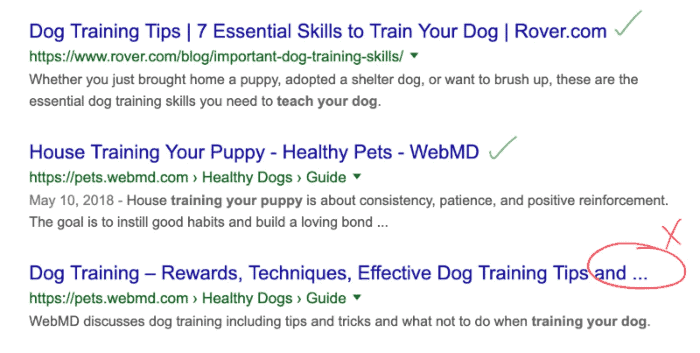
You might have the best content out there on a particular subject, but if your headline is lacking, you’ll get far fewer clicks and views on that content.
Research shows that using numbers and power words, when possible, in your headlines can improve the click-through rate.
It’s not enough to just convey what your blog post is about. You should also include alliteration to get attention and emotion to make your headlines more compelling. You can also include the current year in the title to make your content more relevant.
Consider using a headline analyzer tool if you need some help or inspiration here.
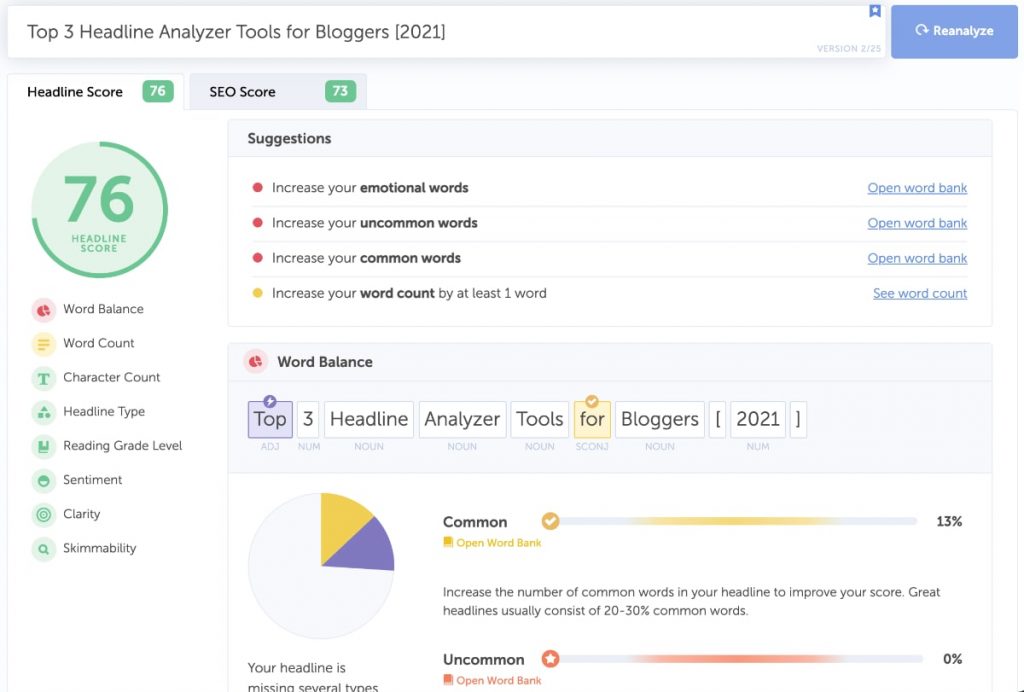
You can also check out what the top competitors on the first page of Google are using for their headlines and check to see how yours will look with Moz’s title tag review tool.
Site Speed and Performance
Lastly, let’s talk about site speed and performance. You may not think that this is super important when it comes to how you promote your blog, but it actually is.
Site speed and performance are critical for how users interact with your blog.
Poor website speed and performance can lead to higher bounce rates, lower user engagement, and decreased conversions.

Basically, if your website takes too long to load, visitors will likely abandon the page before they even have a chance to look at your content.
This is especially bad because it also signals to Google that your website provides a bad user experience and your content will drop in search rankings accordingly.
How to Improve Your Performance
The first step to improve your site performance is to check it using a tool like Google PageSpeed Insights.
This will give you a score on your content and identify areas that you can improve, but it can also be a little technical and overwhelming if you aren’t a web developer.
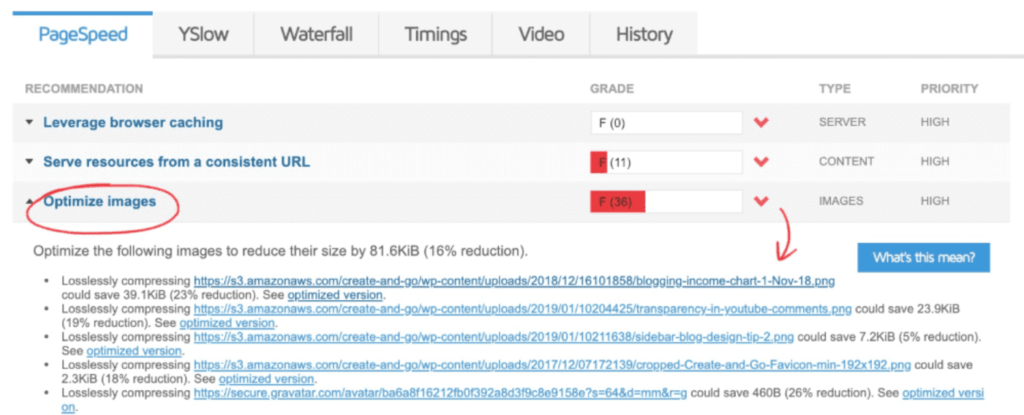
You may need to read up on how to interpret your PageSpeed results to better understand how you can fix the errors.
To ensure a smooth experience for your readers, make sure that you optimize the loading speed of your blog by compressing images and minifying HTML, CSS, and JavaScript files.
Additionally, consider implementing content delivery networks (CDNs) or leveraging caching solutions which can help reduce server load times and improve overall site performance.
Another simple fix that you can use is to install plugins that can help with these issues. WPRocket is a great all-around tool to enhance site performance.
Make sure you also consider your mobile experience because most users access websites on their mobile phones these days.

Make sure that all of your pages are properly optimized for mobile devices so that visitors get the best experience possible regardless of how they access your content.
It’s also important to monitor how visitors interact with your blog once they land on it by tracking how many pages they view and how much time they spend on each page before navigating away from the site. This will give you insight into how users engage with your content and how well it resonates with them.
Using analytics tools such as Google Analytics is one way to measure this activity over time so you can understand how people use and interact with your website more clearly.
4. Email Marketing
Email marketing is one of the most effective methods you can use to promote your blog because it allows you to reach out to a large audience in a direct and personal way.
You can use it to keep your subscribers up-to-date on new blog posts and other content while also incentivizing them to return to your site frequently. You can also use it as a powerful marketing and selling tool for your products.
We have also used our email list to share webinars, partnerships, and promotions with other brands as part of our affiliate marketing strategy. Email marketing has helped us to grow and scale our blog in so many ways over the years. It’s not a matter of “if” but “when” you should start your email list.
Build Your Email List
You should start building an email list as soon as you start creating and promoting content.
The first step to building your email list is to create an opt-in, also called a lead magnet. This is basically a “freebie” that entices visitors to sign up for your email list because most people aren’t incentivized enough by a “newsletter.”
You can also offer special discounts, as you’ve probably seen on many eCommerce sites.
Your email opt-in should be as closely related to your content (and possibly products) as possible to make sure that you are attracting a target audience.
Our favorite tool for building and growing an email list is Kit. With Kit’s free plan, you can start building your email list for free and use their forms and landing pages to advertise your freebie and create your opt-in.

Canva is another great tool for creating a freebie. You can use it to create images, downloadables, printables, and more.
Make sure to write a good welcome email that introduces yourself and your business and that also provides them with the freebie that they signed up for.
Optimize Your Opt-Ins
Once you have created your opt-ins and welcome email, you should continue to optimize your opt-ins to get maximum exposure and conversions. For example, if you start out with a simple form, you should also create a nice landing page for your opt-in.
Check the analytics for your email marketing platform to see how many people are signing up for your email list every day and where they are coming from. You can create multiple forms and landing pages for different platforms (i.e. podcast, YouTube, blog, TikTok, etc.). This will help you determine where most of the traffic is coming from.
Monitor the analytics over time to see which posts and platforms are driving the most traffic to your opt-ins. If you don’t feel like enough people are signing up for your email list, consider creating new lead magnets (freebies) or changing up your forms and landing pages.

Continue to experiment with your opt-ins until you feel that they are converting well enough.
Ideally, your landing pages should convert at around 50% whereas forms at the bottom of your blog posts should convert at around 2%.
Engage with Your Audience
When you send out content to your audience, make sure you don’t focus too heavily on the promotion side of it. You should always remember “what’s in it for them” and provide value first before you ask for a click or a sale.
It is important to create a connection and engage with your audience in emails for several reasons. By providing meaningful content that resonates with your audience, you can start to build relationships and trust with them.
By sharing personal experiences and stories, you become more relatable to your audience and deepen that connection.
Trust, reliability, and the connections you form with your audience are what drive sales and conversions.
By understanding how people are responding to your emails, you can also tailor the content of future emails even more closely to their interests and preferences.
Monitor Engagement
You can monitor the open rates and click-through rates in your emails to see which emails are driving more engagement. Send out more of that content.
Engaging regularly with your subscribers will also help keep them engaged and interested in what you have to offer as a business. It makes them more likely to pay attention to your promotion of paid products.
Finally, staying connected through email helps show how much you value their opinion and feedback so they know how important they are to you and your business.
You can use survey software to send out surveys on what kind of content or products your audience wants to see more of. This has been an invaluable feedback tool in our success.
You should also experiment with how often and how aggressively you send emails—too many might cause subscribers to unsubscribe, while too few may not be enough to remain top of mind.
A/B testing different subject lines and calls-to-action (CTAs) will help give you insight into how well different strategies work for your subscribers.
Engaging regularly through email is essential if you want to maintain a successful relationship with customers while promoting your blog’s latest content at the same time!
Create an Email Sales Funnel
Finally, creating an email sales funnel is an essential component of marketing your blog and your products.
An effective sales funnel allows you to:
- nurture leads,
- deepen relationships with your subscribers,
- and maximize conversions from your blog content.
With an email sales funnel, you can create targeted emails that focus on specific customers’ needs and provide them with valuable content.
You can customize the emails you send out to each customer or segment of customers so that they are more likely to engage with your content and take action.
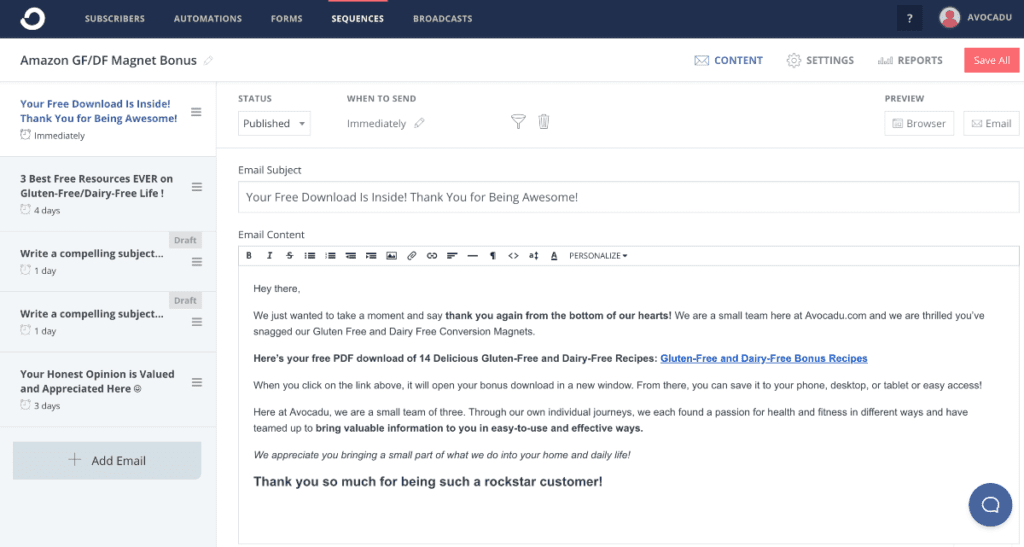
For example, if you offer a free trial for your product, you can create a series of emails designed to inform customers and encourage them to sign up.
Or if you have a blog post about how to save money on groceries, you could target those emails specifically to those who are interested in saving money.
An email sales funnel is one of the best ways to put your blog promotion strategy on autopilot and “make money while you sleep” as they say.
It can make your blog monetization more passive because you can set up your emails to send out automatically and drive people to your sales pages over and over again with the same emails.
When you’re creating your own email sales funnel, you should aim for anywhere from 5-10 emails sent out on consecutive days.
Make sure to provide a lot of value before you ask for the sale and include discounts and limited-time offers wherever possible to create scarcity and incentive people to buy now.
5. Content Marketing and Social Media
Content marketing and social media are the more traditional methods to promote your blog that you’ve probably been thinking about all along, but it was important to take the right steps to get here.
Before you promote your blog content, it should be targeted and optimized as we discussed earlier.
Content marketing involves creating content that is relevant to your audience and then strategically distributing it across various channels, like email and social media.
With the right content strategy, you can build relationships with potential customers while also increasing brand awareness.
Social Media Marketing
Social media is an effective part of content marketing to distribute content and engage with your audience.
By posting regularly on platforms such as Instagram, TikTok, Instagram, YouTube, or your Facebook group, you can interact with followers, spread the word about new blog posts, and provide valuable information to those who follow you.
You can use hashtags and paid campaigns to increase visibility and target specific audiences on these platforms.
You can also monitor your content marketing strategies by tracking analytics such as click-through rates (CTRs) and engagement metrics like likes, shares, and comments.
This data provides insights into what resonates best with your readers so that you can better tailor your future content accordingly.
Types of Content
There are so many different types of content that you can create as a blogger — aside from the more traditional blog writing.
Different types of content — written, voice, video — have different impacts and delivery methods. For example, written content is really great for longer, informative, and educational posts about certain topics.
Voice and video content can provide you with a way to reach your audience on a deeper level because they are more personal. They’re also harder to create, making them less competitive.
Written content is ideal for search platforms like Google and Pinterest. Video content is better suited for social media sites like YouTube, TikTok, and Instagram.
It’s important to create awesome content that you feel comfortable with creating but also that resonates well with your target market. If your target audience spends most of their time on a social media channel like YouTube, it’s probably not a good idea to focus solely on Pinterest.
Written Content
Let’s talk first about how you can promote your blog with written content.
We’ve already covered this pretty extensively as it relates to Google SEO. Even if you aren’t actively trying to get Google traffic, you should still make sure that you have the basics covered so that you can naturally grow over time.
In the very least, consider some keyword research and basic SEO. Consider optimizing and updating your content over time.
One platform that is great for written content that we haven’t discussed yet is Pinterest. Pinterest, like Google, is a social network with a core search function, but it also has a visual element that is used as a “discovery” tool.
When you use Pinterest to drive traffic to your blog, you can create “pins” or images to advertise your new blog post.
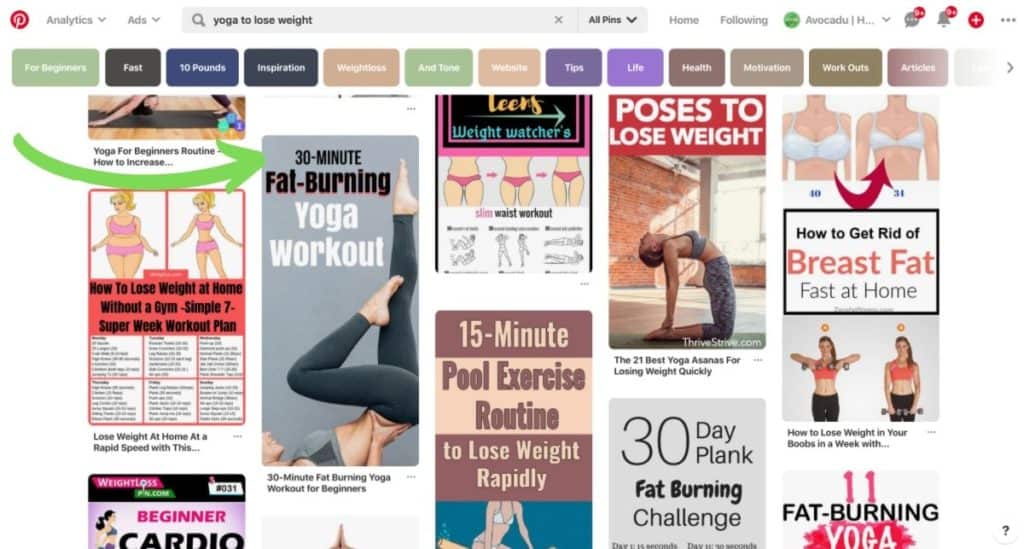
You can also create stories and video content similar to Instagram that can help increase your brand awareness and engagement on the platform.
Overall, Pinterest has far fewer users than Google and therefore less traffic, but it’s also significantly less competitive than Google.
It can be a really great place for beginners to start driving traffic.
Voice Content
If you want to add more depth to your content and reach people on a different platform, you might want to consider starting a podcast. Podcasts are relatively easy to get started and cost very little (other than your podcast hosting company).
You can start out by discussing the topics that you have already written about on your blog and then adding those episodes to your existing blog posts to give people an alternative medium to absorb your content.
A podcast can also be a really great way to network with other bloggers and make important connections in your niche by inviting others to be guests on your podcast. This makes it even easier to create and share this type of content because you’re just having a conversation with others.
Make sure to use some basic (or free) audio editing software to edit out mistakes and unwanted pauses from your podcast recordings.
Video Content
Finally, video content is the most personal and arguably the most impactful form of content.
It’s hard to get your face on camera and be vulnerable to the world, and people are attracted to that vulnerability.
It builds trust and relationships faster than any other type of content and also helps to make sales better than most other types of content.
Video content shared on a social network like YouTube channel can be a really great supplemental source of traffic for blogs.
YouTube
Having a YouTube channel can be a great addition to any blog. YouTube is the world’s second-largest search engine, with more than 2 billion monthly active users, making it an ideal platform for reaching potential viewers and growing your blog’s audience.
YouTube videos offer another way for content to be presented and experienced in a more dynamic format, offering a more engaging way to consume content.
It can also improve your SEO performance when you embed YouTube videos in your blog posts to boost the relevancy to your reader and increase the time that they spend on your page.
You don’t have to be a professional to make money on YouTube, but even using some basic (or free) video editing software can make your videos a lot more impactful and successful.
As with all other content, make sure that your YouTube videos:
- offer valuable information that your audience is looking for,
- are SEO-optimized with relevant and important keywords,
- and include a call-to-action to get more subscribers, sign up for an email list, or check out a product.
Instagram and TikTok
Instagram and TikTok are two of the most popular social media platforms out there, and they can also be great additions to any blog.
With over 1 billion monthly active users on each platform, both Instagram and TikTok offer huge potential audiences for bloggers looking to increase their reach.
These platforms are fairly similar, but with Instagram, you can create static posts as well as video content like reels and stories. TikTok is a social network with solely video content.
TikTok is great for quick, fun, and unique content that can reach a wide audience in just a few minutes.
It’s also great for creating longer-form video content with the “story” feature, where users can share information more in-depth than they could on Instagram.
Make sure to use relevant hashtags whenever you can to increase the organic reach of your content on Instagram.
You can make money with Instagram or TikTok, but it also depends a lot on who your target audience is and where they spend their time. TikTok is used more by a younger audience and Gen Z while Instagram is more popular with Millenials.
Influencer Marketing
Influencer marketing is another effective tool to use on these platforms to get your content in front of a larger audience.
You can work with influencers to share your content across their social media channels or create sponsored or paid advertising posts featuring them.
Research into who would be a good fit for your blog will help you make sure you’re working with the right people for maximum engagement from the desired audience.
Webinars
Lastly, webinars are another form of video content that can also be used as a powerful promotion tool for bloggers.
Webinars give bloggers the opportunity to engage with readers in a private, distraction-free space in real time, providing content that is both interesting, engaging, and promotional in nature.
Webinars can be a really great way for bloggers to share educational and valuable content before sharing more about their products or services and closing with a limited-time sale.
When creating your webinar, it is important to make sure that the content is interesting and engaging throughout the entire presentation so that your audience doesn’t get bored and leave.
It’s also important to use webinar software to host your webinars to make sure that the information is presented well and without disruptions.
Webinars are also very effective to use with promoted ad campaigns. You can drive traffic from paid advertising straight to an opt-in page for your webinar and use webinar software to show your webinar in demand (making it a very passive income source).
Online Communities
Community groups are another way that you can connect with your audience and promote your blog. They provide yet another way to reach your audience and engage with them in a more personal way.
You can connect with people in community groups that you own or in other active community groups in your niche.
If you run your own community group, you’ll need a community platform like Facebook Groups, Slack, Discord, etc.
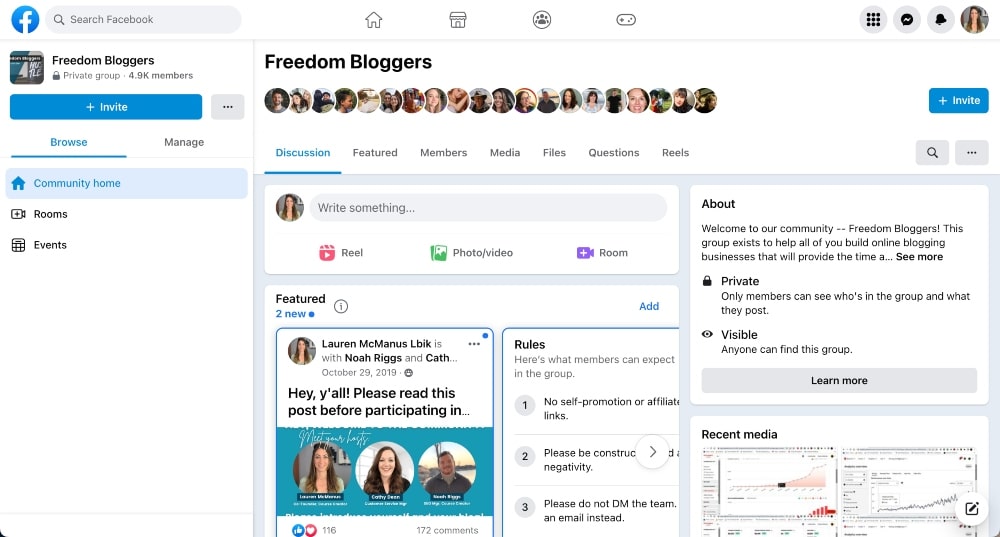
Connecting with your audience in online communities provides another way to build connections, trust, and loyalty.
You can create conversations around topics related to your blog content, host regular Q&A sessions with your followers, exchange ideas and tips, or provide updates and insights.
This type of connection encourages readers to stay involved and engaged with the blog, while also making them feel like they are a part of something bigger than themselves.
Another great thing about using community groups is that you can use it to get feedback from others on how you can improve your content or products.
This feedback can be invaluable when it comes to continuing to update and optimize your content.
Paid Marketing and Ads
Paid promotions (ads) are a great way to quickly promote your blog, create brand awareness, and drive more website traffic. With the right strategies and budget management, you can reach your target audience more effectively.
Social Media Advertising
You can advertise individual social media posts or campaigns using targeting options such as demographics (age, gender), interests, and behavior. This will ensure that your paid promotion is reaching the right people with the right message.
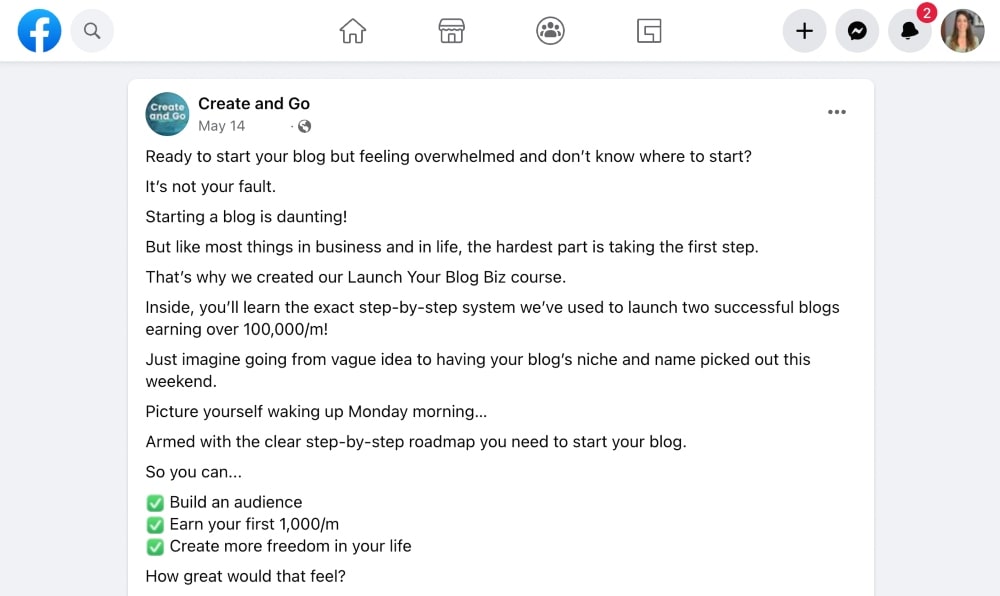
Social media ads on platforms such as Facebook, Instagram, Twitter, LinkedIn, Pinterest, and YouTube are great for boosting visibility. I’m sure you’re used to seeing a paid promotion on practically every other post in your Instagram feed.
Paid advertising can be a great way to generate quick wins in terms of website visits or sales but it does require careful planning and budgeting in order to maximize returns on investment.
Social media advertising is very competitive and it doesn’t take long before competitors copy your ads, so make sure you’re always trying out new campaigns and ideas.
Search Advertising
You can also use Google Ads (formerly Google Adwords) to create campaigns targeting specific keywords related to topics covered on your blog.
Text-based ad units appear at the top of search pages when someone searches for those keywords supplying relevant information about what they are looking for directly from you increasing blog traffic and conversions in the process.
6. Networking and Blogger Outreach
Networking and blogger outreach are great tools to promote your blog because they allow you to connect with potential readers and influencers in your niche.
Aim to build relationships with key people who have the power of a wider audience to spread the word about your blog.
Participate in forums, join conversations on relevant social networks, reach out to bloggers who cover topics related to yours, and offer them collaborations or guest blogging opportunities.
As we mentioned before, using influencer marketing is also an effective way to use network and outreach to promote your blog.
Reach out to influencers and relevant blogs in your niche and collaborate on content that will bring value to their audience while also promoting your blog.
This will give you access to their followers as well as help establish yourself as a credible source of information within the industry.
In order for networking and blogger outreach efforts to be successful, you need to ensure that you are providing high-quality content that provides value for the audience.
Make sure that it’s relevant and engaging for the intended audience and make sure that the blog posts are optimized for SEO when possible.
Building relationships with bloggers and influencers in your niche allows you to create a network of people who can help promote your blog organically.
It’s important not just to reach out but also to make sure that what you’re offering has real value for them too, otherwise, they may not be willing or interested in participating in whatever kind of collaboration or partnership you’re proposing.
Guest Blogging
Writing guest posts is one of the most effective strategies you can use to boost your SEO and promote your blog.
When you write a guest post for someone, you’re writing a blog post or piece of content that will be published on their blog, usually with a link (called a backlink) to your blog.
Writing high-quality blog posts for other sites in your industry or niche can:
- bring more exposure to your blog,
- establish yourself as an expert in the field,
- increase your backlinks and SEO rankings,
- and build credibility with new audiences.
When you write a guest post, it’s important to focus on creating content that is relevant, valuable, and engaging for the target audience.
Don’t just write about your own blog or company – instead, focus on how you can help people who are reading the post.
Writing Guest Posts
When guest posting, make sure to include a do-follow link back to your own blog or a specific blog post where appropriate to provide the readers with a way to find out more about you.
When done correctly, guest blogging can be a great way to generate higher website traffic and conversions while also helping you connect with influencers in your industry.
An added benefit is that search engines will view this kind of content linking back to your blog as an indication of authority which can help boost SEO rankings over time as well.
Keep in mind that when you write a guest post, you can and should share it with your audience but you generally cannot publish the same blog post on your own blog.
Be strategic when choosing how many guest posts you write and who they are written for – aim for sites that have a large following so you maximize visibility for each piece of content created.
Also, make sure that their audience is relevant to yours so you don’t waste time writing a guest post for an audience that won’t be interested in what you have to say.
Partnerships and Affiliate Marketing
Partnerships and affiliate marketing are two effective strategies to promote your blog and earn money while doing so.
You can use partnerships to team up with other bloggers and brands in your niche to increase exposure to your posts, access a wider audience, and sometimes earn money.
For example, we have partnered with other bloggers to sell their courses to our audiences as affiliates. We have also offered our blogging course to be sold by our affiliates.
We have also partnered with top brands in our niche like Bluehost, Teachable, and ConvertKit to do joint webinars, share special campaigns, get custom landing pages, write guest posts, and appear on podcasts. This type of collaboration allows you to get access to the partner’s audience, as well as help build credibility for your blog within the industry.
When developing partnerships, it is important to select partners whose values are in line with yours and whose target audience aligns with yours. It is also key to ensure that the blog content created is valuable for both parties involved.
These partnerships can be beneficial solely because you get access to the brand’s audience if they agree to send out the post or promotion to their audience. But they are even more effective when these brands have affiliate programs for their products or services and you can earn a commission from this partnership.
Make sure that any products or services that you recommend align with the topics covered on your blog, are of high quality, and are relevant to your audience.
7. Measuring Your Success
As you can see, a lot of work goes into effectively promoting your blog and sharing it effectively on social media sites.
You need to create the right strategy at the right time for your blog and your audience and you’ll need to modify and update it along the way to continue to grow and scale.
That’s why, when you’re learning how to promote your blog, it’s important to measure how well your efforts are working. This will help you adjust and optimize your strategy as needed, along the way, to ensure better results in the future.
It’s better to find out what’s not working earlier rather than later so that you don’t get left behind while the competition soars ahead of you.
Goals and Metrics
The first step is to determine how you want to measure success. This could be through blog traffic, conversions, or engagement rate with content.
It’s important to set SMART goals from the beginning that are specific, measurable, achievable, relevant, and time-based.

This will outline how you plan to measure and track the progress of specific strategies from the beginning.
Once you have established how you want to track progress, create a baseline by tracking metrics like unique pageviews for each post or the total number of followers on social media accounts. This data will help you keep track of how much progress has been made over time.
Google Analytics and Other Tools
You can also use tools like Google Analytics to get more detailed insights into how users are interacting with each new blog post, such as average session duration and bounce rate. These metrics can help you determine which pieces of content are resonating with visitors and how they are engaging with them.
Monitor your blog traffic stats closely to see who is visiting your site, how often people are visiting your site, and where they are visiting your site from.
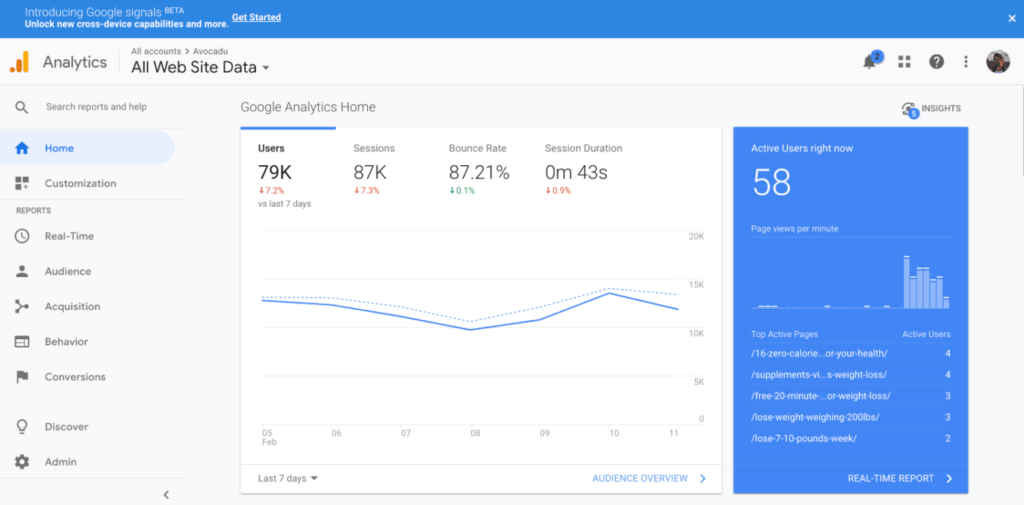
This is all key information to help you decide to do more of what’s working and less of what isn’t.
Make sure to set up Google Analytics on your website as soon as possible, if you haven’t already. Google Analytics doesn’t automatically track your website data. You have to give it permission to do so. Read more about how to set it up here.
Additionally, utilize any analytics from any other tools that you’re using.
For example, we have access to analytics on a variety of different platforms that we use to promote our blog, including:
- Ahrefs for SEO
- Kajabi or Online Courses
- Tailwind for Pinterest
- ConvertKit for Email Marketing
- BuzzSprout for Podcast Downloads
- YouTube Analytics for Views and Subscribers
There are also tons of other tools for measuring social media analytics such as growth in views, subscribers, downloads, followers, and more for whatever platform you are using.
Experiment with different tools for optimization and growth and find what works best for you and your blog.
Summary of How to Promote Your Blog
You can promote your blog using a variety of strategies such as SEO, social media marketing, partnerships, paid campaigns, guest posting, online communities, email marketing, and more.
Make sure to set yourself up for success by building the right foundation and taking the time to identify your target audience and what kind of content they are interested in. Pair this target audience with the right content and the right platform to reach the right people at the right time.
It is important to measure how well these strategies are working in order to optimize them and ensure better results in the future.
To track progress, set SMART goals and create baselines with metrics like unique pageviews and total followers. Tools like Google Analytics can be used to get insights into how users interact with content while other analytics tools can help track information on social media posts.
Experimenting with different tools for optimization is key to finding what works best for your blog promotion strategy.
We hope you enjoyed this blog post on how to promote your blog!
